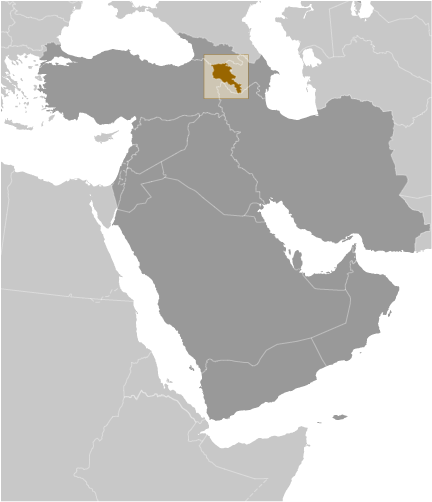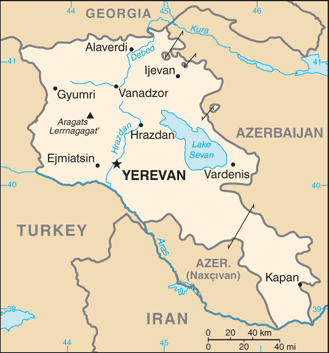
|
|
Advertisements:
EconomyEconomy - overview
Fter several years of double-digit economic growth, Armenia faced a severe economic recession with GDP declining more than 14% in 2009, despite large loans from multilateral institutions. Sharp declines in the construction sector and workers' remittances, particularly from Russia, led the downturn. The economy began to recover in 2010 with 2.1% growth, and picked up to 4.6% growth in 2011. Under the old Soviet central planning system, Armenia developed a modern industrial sector, supplying machine tools, textiles, and other manufactured goods to sister republics, in exchange for raw materials and energy. Armenia has since switched to small-scale agriculture and away from the large agroindustrial complexes of the Soviet era. Armenia has managed to reduce poverty, slash inflation, stabilize its currency, and privatize most small- and medium-sized enterprises. Armenia's geographic isolation, a narrow export base, and pervasive monopolies in important business sectors have made it particularly vulnerable to the sharp deterioration in the global economy and the economic downturn in Russia. The conflict with Azerbaijan over the ethnic Armenian-dominated region of Nagorno-Karabakh contributed to a severe economic decline in the early 1990s and Armenia's borders with Turkey remain closed. Armenia is particularly dependent on Russian commercial and governmental support and most key Armenian infrastructure is Russian-owned and/or managed, especially in the energy sector. The electricity distribution system was privatized in 2002 and bought by Russia's RAO-UES in 2005. Natural gas is primarily imported from Russia but construction of a pipeline to deliver natural gas from Iran to Armenia was completed in December 2008, and gas deliveries expanded after the April 2010 completion of the Yerevan Thermal Power Plant. Armenia's severe trade imbalance has been offset somewhat by international aid, remittances from Armenians working abroad, and foreign direct investment. Armenia joined the WTO in January 2003. The government made some improvements in tax and customs administration in recent years, but anti-corruption measures have been ineffective and the economic downturn has led to a sharp drop in tax revenue and forced the government to accept large loan packages from Russia, the IMF, and other international financial institutions. Amendments to tax legislation, including the introduction of the first ever "luxury tax" in 2011, aim to increase the ratio of budget revenues to GDP, which still remains at low levels. Armenia will need to pursue additional economic reforms and to strengthen the rule of law in order to regain economic growth and improve economic competitiveness and employment opportunities, especially given its economic isolation from two of its nearest neighbors, Turkey and Azerbaijan. Gdp (purchasing power parity) World Ranking: 133
$18.17 billion (2011 est.)
$17.41 billion (2010 est.) $17.05 billion (2009 est.) Note Data are in 2011 US dollars Gdp (official exchange rate)
$10.11 billion (2011 est.)
Gdp - real growth rate World Ranking: 84
4.4% (2011 est.)
2.1% (2010 est.) -14.2% (2009 est.) Gdp - per capita (ppp) World Ranking: 146
$5,500 (2011 est.)
$5,300 (2010 est.) $5,200 (2009 est.) Note Data are in 2011 US dollars Gdp - composition by sector
Agriculture 19.1%
Industry 40.5% Services 40.3% (2011 est.) Labor force World Ranking: 138
1.194 million (2011 est.)
Labor force - by occupation
Agriculture 44.2%
Industry 16.8% Services 39% (2008 est.) Unemployment rate World Ranking: 60
5.9% (2011 est.)
7.1% (2007 est.) Population below poverty line
35.8% (2010 est.)
Household income or consumption by percentage share
Lowest 10% 3.7%
Highest 10% 25.4% (2008) Distribution of family income - gini index World Ranking: 110
30.9 (2008)
44.4 (1996) Investment (gross fixed) World Ranking: 8
35.4% of GDP (2011 est.)
Budget
Revenues $2.27 billion
Expenditures $2.57 billion (2011 est.) Taxes and other revenues World Ranking: 141
22.5% of GDP (2011 est.)
Budget surplus (+) or deficit (-) World Ranking: 99
-3% of GDP (2011 est.)
Public debt World Ranking: 85
38.6% of GDP
39.3% of GDP Inflation rate (consumer prices) World Ranking: 166
7.7% (2011 est.)
8.2% (2010 est.) Central bank discount rate World Ranking: 40
8% (11 January 2012)
7.25% (2 December 2008) Note This is the Refinancing Rate, the key monetary policy instrument of the Armenian National Bank Commercial bank prime lending rate World Ranking: 23
17.75% (31 December 2011 est.)
18.9% (31 December 2010 est.) Note Average lending rate on loans up to one year Stock of narrow money World Ranking: 135
$1.663 billion (31 December 2011 est.) $1.201 billion (31 December 2010 est.) Stock of broad money World Ranking: 141
$2.92 billion (31 December 2011 est.) $3.708 billion (31 December 2010 est.) Stock of domestic credit World Ranking: 123
$3.31 billion (31 December 2011) $2.634 billion (31 December 2010) Market value of publicly traded shares World Ranking: 117
$43.52 million (31 December 2011) $27.99 million (31 December 2010) $140.5 million (31 December 2009) Agriculture - products
Fruit (especially grapes), vegetables; livestock Industries
Diamond-processing, metal-cutting machine tools, forging-pressing machines, electric motors, tires, knitted wear, hosiery, shoes, silk fabric, chemicals, trucks, instruments, microelectronics, jewelry manufacturing, software development, food processing, brandy, mining Industrial production growth rate World Ranking: 5
14.1% (2010 est.)
Electricity - production World Ranking: 100
7.432 billion kWh (2011 est.)
Electricity - consumption World Ranking: 110
5.8 billion kWh (2011 est.)
Electricity - exports
1.36 billion kWh
Note Armenia exports an unknown quantity to Georgia; includes exports to Nagorno-Karabakh region in Azerbaijan (2011 est.) Electricity - imports
17 million kWh; note - imports an unknown quantity from Iran (2008 est.) Oil - production World Ranking: 150
0 bbl/day (2010 est.)
Oil - consumption World Ranking: 95
52,000 bbl/day (2010 est.)
Oil - exports World Ranking: 133
0 bbl/day (2009 est.)
Oil - imports World Ranking: 87
46,680 bbl/day (2009 est.)
Oil - proved reserves World Ranking: 103
0 bbl (1 January 2011 est.)
Natural gas - production World Ranking: 148
0 cu m (2011 est.)
Natural gas - consumption World Ranking: 80
2.077 billion cu m (2011 est.)
Natural gas - exports World Ranking: 54
0 cu m (2011 est.)
Natural gas - imports World Ranking: 48
2.077 billion cu m (2011 est.)
Natural gas - proved reserves World Ranking: 147
0 cu m (1 January 2011 est.)
Current account balance World Ranking: 127
-$1.258 billion (2011 est.)
-$1.3 billion (2010 est.) Exports World Ranking: 150
$1.305 billion (2011 est.)
$1.113 billion (2010 est.) Exports - commodities
Pig iron, unwrought copper, nonferrous metals, diamonds, mineral products, foodstuffs, energy Exports - partners
Russia 15.4%, Germany 13.9%, Iran 9.8%, Bulgaria 9.3%, Netherlands 7.8%, US 7.6%, Spain 7.6%, Canada 5.7%, Belgium 5.5%, Georgia 4.6% (2011) Imports World Ranking: 140
$3.503 billion (2011 est.)
$3.255 billion (2010 est.) Imports - commodities
Natural gas, petroleum, tobacco products, foodstuffs, diamonds Imports - partners
Russia 20%, China 8.1%, Ukraine 6.8%, Iran 6.5%, Germany 5.9%, Italy 4.7% (2011) Reserves of foreign exchange and gold World Ranking: 120
$1.959 billion (31 December 2011 est.) $1.866 billion (31 December 2010 est.) Debt - external World Ranking: 103
$7.336 billion (30 September 2011) $6.103 billion (31 December 2010 est.) Exchange rates
Drams (AMD) per US dollar -
372.5 (2011 est.) 373.66 (2010 est.) 363.28 (2009) 303.93 (2008) 344.06 (2007) Fiscal year
Calendar year
Comments
Add a new comment: |
Advertisement
Members area
Armenia (Yerevan):
 
GPS points from Armenia (Yerevan)
|
||||||||

 Armenia prides itself on being the first nation to formally adopt Christianity (early 4th century). Despite periods of autonomy, over the centuries Armenia came under the sway of various empires including the Roman, Byzantine, Arab, Persian, and Ottoman. During World War I in the western portion of Armenia, Ottoman Turkey instituted a policy of forced resettlement coupled with other harsh practices that resulted in at least 1 million Armenian deaths. The eastern area of Armenia was ceded by the Ottomans to Russia in 1828; this portion declared its independence in 1918, but was conquered by the Soviet Red Army in 1920. Armenian leaders remain preoccupied by the long conflict with Azerbaijan over Nagorno-Karabakh, a primarily Armenian-populated region, assigned to Soviet Azerbaijan in the 1920s by Moscow. Armenia and Azerbaijan began fighting over the area in 1988; the struggle escalated after both countries attained independence from the Soviet Union in 1991. By May 1994, when a cease-fire took hold, ethnic Armenian forces held not only Nagorno-Karabakh but also a significant portion of Azerbaijan proper. The economies of both sides have been hurt by their inability to make substantial progress toward a peaceful resolution. Turkey closed the common border with Armenia in 1994 in support of Azerbaijan in its conflict with Armenia over control of Nagorno-Karabakh and surrounding areas, further hampering Armenian economic growth. In 2009, senior Armenian leaders began pursuing rapprochement with Turkey, aiming to secure an opening of the border.
Armenia prides itself on being the first nation to formally adopt Christianity (early 4th century). Despite periods of autonomy, over the centuries Armenia came under the sway of various empires including the Roman, Byzantine, Arab, Persian, and Ottoman. During World War I in the western portion of Armenia, Ottoman Turkey instituted a policy of forced resettlement coupled with other harsh practices that resulted in at least 1 million Armenian deaths. The eastern area of Armenia was ceded by the Ottomans to Russia in 1828; this portion declared its independence in 1918, but was conquered by the Soviet Red Army in 1920. Armenian leaders remain preoccupied by the long conflict with Azerbaijan over Nagorno-Karabakh, a primarily Armenian-populated region, assigned to Soviet Azerbaijan in the 1920s by Moscow. Armenia and Azerbaijan began fighting over the area in 1988; the struggle escalated after both countries attained independence from the Soviet Union in 1991. By May 1994, when a cease-fire took hold, ethnic Armenian forces held not only Nagorno-Karabakh but also a significant portion of Azerbaijan proper. The economies of both sides have been hurt by their inability to make substantial progress toward a peaceful resolution. Turkey closed the common border with Armenia in 1994 in support of Azerbaijan in its conflict with Armenia over control of Nagorno-Karabakh and surrounding areas, further hampering Armenian economic growth. In 2009, senior Armenian leaders began pursuing rapprochement with Turkey, aiming to secure an opening of the border.